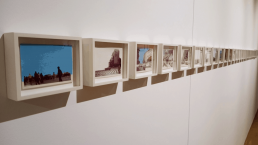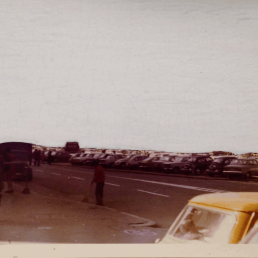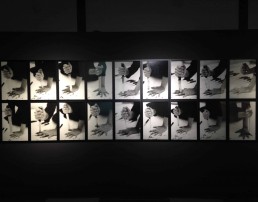Exhibitions and Fairs
Marina Abramović – The Cleaner
Retrospective at the Museum of Contemporary Art Belgrade
By Shira Wolfe

“The most difficult thing is to have good ideas. If you have two good ideas, that makes you a genius. I believe that I had one good idea – to work with my body.” - Marina Abramović
On September 21st, Marina Abramović’s retrospective Čistač (The Cleaner) opened in Belgrade at the Museum of Contemporary Art. Belgrade is the last stop on the exhibition’s European tour, which began at the Moderna Museet in Stockholm in 2017. The exhibition reviews all the phases of the artist’s career, from her works of the early 1960s up to the present day. This exhibition is particularly significant as it is the first time in 44 years that Marina Abramović exhibits in her native Belgrade. In the spirit of the physical challenges of performance art and the topic of the exhibition, “cleaning,” the press conference was held at 6:23 am the morning of the exhibition opening.
“Cleaning is a metaphor for me; cleaning of the past, the cleaning of your mind.” - Marina Abramović
Marina Abramović at 6:23 am
Serbia is deeply divided over the return of Marina Abramović, and the exhibition and her visit caused a gigantic stir for months before she came. Born in the centre of Belgrade, the artist created boundary-breaking performance art at Belgrade’s Student Cultural Centre with fellow artists during the 1970s before moving to Amsterdam and eventually New York. During that period of the 1960s and 1970s in Yugoslavia, no one was doing art in this way. Yet with her departure from Yugoslavia and her great international success also came a great deal of hatred from people who believed she had sold out, and abandoned her roots, particularly during the falling apart of Yugoslavia and the years of heavy war in the Balkans. During the early morning press conference when Abramović managed to get the press out of bed before sunrise, she read quotes from such critics in a newspaper article that had just been published the day before: “But that isn’t performance. This is just shit. I do this every day,” she quoted.
One of the main critiques of Abramović’s retrospective in Belgrade is the large amount of money that was spent on the exhibition. Responding to a question about the high costs of the exhibition, Abramović says: “I’m not a politician, I’m an artist. But if politicians want to invest a lot of money into exhibitions, these exhibitions are able to reach a world-class level. I hope that this will help the museum to receive money to make high-quality exhibitions in the future.”
She is quick to dismantle false notions of celebrity. When asked about her fame, Abramović quotes Woody Allen: “Today I’m a star, tomorrow I’m a black hole.” She elaborates that she was not famous in her 20s, 30s, or 40s. Fame came in her 50s. “People made a star out of me, I didn’t do that,” she states. “In my manifesto I say: The artist shouldn’t be an idol, but just be him, or herself.” The artist should put their ego on the side, because the work is more important. And in order to create her inimitable work, she has had to sacrifice a great deal. In the words of Abramović: “I didn’t have children. I couldn’t have a normal life. I am a modern nomad.”



Marina Abramović’s Visual Art – Clouds and Airplanes
Most people don’t know that before Marina Abramović was a performance artist, she worked in more conventional pictorial media. As a young artist, she often spent time lying in fields and staring up at the sky, compiling theories about the clouds and their shadows. One day, lying there, she found herself staring up at a cloudless blue sky. Suddenly, military planes flew over, leaving a painting in the sky which gradually disappeared. Abramović describes this experience as a spiritual revelation which made her realise she did not have to limit herself to painting two-dimensionally in a studio. She understood then that everything can be used to make art, including one’s own body. Another thought struck her – the fact that what the airplanes had drawn in the sky was immaterial and simply came and went, leaving nothing behind. These thoughts were to inspire her in her move towards performance art in which one creates art with the body, art which is inherently ephemeral and immaterial.
The visual art exhibited in the retrospective is striking. On the wall hangs a self-portrait from 1965 and a portrait of her grandmother from 1969, painted in a dark, emotive style reminiscent of German and Austrian Expressionists such as Kirchner and Schiele.

Next follows her cloud series. Between 1965 and 1970, Abramović painted different compositions inspired by her experience watching the sky. “Cloud With its Shadow” and “Body and Cloud with its Shadow” portray a large, bulky body with studies of a cloud and its shadow. In “Body and Clouds, Study No. 1” and “Body and Clouds, Study No. 2”, wiry charcoal legs cut through a white sky with blue clouds. These paintings already foreshadow Abramović’s use of the body as art. These are the connecting pieces between Abramović’s beginnings in art and the path she subsequently pioneered. “Black Clouds Coming” and “Clouds Collage” are powerful surrealist works which are indebted to Magritte. She further conceptualises the study of clouds with her framed peanut, which casts a shadow which in turn becomes a cloud.
Another series from her pre-performance period is “Freeing the Horizon” (1971). This series consists of small urban landscape photographs, each of which includes important buildings of central Belgrade in the composition. Abramović then removed the buildings from the photographs by painting over them, and in the process, “freeing the horizon”. She had always felt slightly suffocated by all the buildings, and this way she could breathe. Many of the buildings obscured in these works were eventually destroyed by bombs during the war in 1999.
The exhibition continues the connection between her visual and performance art by showing her sketches for some of her first performance pieces, including Rhythm 10 and Rhythm 5.
Marina Abramović's Reperformances
12 performers from over 100 were selected to enact the live reperformances of Marina Abramović’s historical works and to take part in her intensive three-day master class. By offering them a spot in her special master class, Abramović wishes to support young artists by providing them with the kind of training that was never available to her when she was a young artist. After all, she explained, nobody was teaching this kind of performance art back in her day. Throughout the entire run of the exhibition, 11 of Abramović’s performances will be reperformed by young local and international performers. The casting process involved conversations about why this rigorous project is relevant for the performers at this particular point in their lives.
At the time of the opening, the following pieces were being reperformed by the selection of young performers:
Artist’s Life Manifesto (1997)
The artist reads her life manifesto in English. During the opening, ten performers shouted Marina Abramović’s life manifesto.
Freeing the Body (1975)
With her head wrapped in a black scarf the artist moves to the rhythm of an African drum beat until she falls to the floor completely exhausted.
Art Must Be Beautiful, Artist Must Be Beautiful (1975)
The artist sits on a chair and aggressively brushes and combs her hair whilst constantly repeating the phrase “Art Must Be Beautiful, Artist Must Be Beautiful,” until she scratches her face and tears her hair.
Work Relation (1978)
Marina and Ulay here did heavy physical work: they carried stones back and forth in metal buckets, without any result. Visitors are given the opportunity to participate in the reperformance at certain times.
Imponderabilia (1977)
Naked and motionless Marina and Ulay spent ninety minutes standing facing each other in a narrow entrance passage to the museum in Bologna, forcing visitors who wished to enter to squeeze between them.
Relation in Time (1977)
Marina and Ulay are sitting back to back, motionless and tied together by their hair. When the audience enters, they continue sitting like this for one more hour.
“I don’t want to spend every day in the studio. In fact, I don’t spend every day in the studio at all. I live my life, and inspiration comes.” - Marina Abramović


Marina Abramović’s Seminal Works
Aside from the live reperformances, video installations, objects, scenography, sound works, photographs and archival materials portray the rest of Abramović’s vast range of performance pieces. The spaces are filled with their various sounds and noises, echoing after you as you walk past the artist’s face throughout the years, at times alone, at times with former collaborator Ulay, at times represented by young performers.
Groundbreaking works presented in the retrospective include her “Rhythm” works (1973-1974), “Lips of Thomas” (1975), “Relational works” (1976-1977), “Nightsea Crossing” (1982-1986), “Balkan Baroque” (1997), “The House with the Ocean View” (2002) and “Artist is Present” (2010). “Rhythm 0” is Abramović’s infamous performance piece in which she allowed the audience to choose objects she had laid out which they could use on her naked body in whichever way they liked. For “The House with the Ocean View,” Abramović spent 12 days inhabiting a temporary space in the Sean Kelly Gallery in New York, exposing all of her actions to the public. The “Nightsea Crossing” works were conceived together with Ulay, and presented between the early and mid-1980s. In these performance pieces, the pair sat silently and motionless for hours on end, extending up to 16 days.
The Artist’s Presence
Marina Abramović has returned to Belgrade, and in so doing asks people to consider whether they are able to give not 100%, but 150% of themselves in what they are doing. This is the question that rings in one’s ears after leaving the exhibition, along with extraordinary inspiration to stop caring about other people’s opinions, to let go of fear, and to not simply be or think, but above all to do. “Kad mi se kaže ne, to je početak.” (When they tell me no, that’s the beginning.)

Museum
Museum of Contemporary Art Belgrade
Opening year
1958
Opening Times
Wed – Mon
10-18
Closed on Tuesdays
+381/11 3115713
Address
Ušće 10, Belgrade






